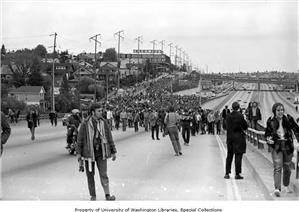From a police officer's vantage point, former UW police officer David Wilma recounts the anti-war protests of May 5, 1970, a response to the United States invasion of Cambodia during the Vietnam War. The movement of demonstrators from jurisdiction to jurisdiction could be traced on the faces of the assembled authorities.
A Policeman's View
"On May 5, 1970, over 1,000 protestors came together on I-5, blocking southbound lanes, to speak out against the US's invasion of Cambodia, and the death of four Kent State antiwar protestors, shot by members of the National Guard.
"I was a University of Washington campus policeman in 1970, assigned to man a police radio in the Administration Building command center during 'Unusual Occurrences,' as demonstrations and other events were termed at the time. On the top floor of the building there was a conference room equipped with a radio outlet and phone line and it was my job to connect [UW] President Charles Odegaard and his staff with the University Police. It was also a place for representatives of other agencies such as the National Guard, Seattle Police, and the Washington State Patrol to collect in the event additional forces were needed at the University.
"The day of the first freeway march, the University officials were understandably tense since all the activity was on their "turf." Then the reports came in as the demonstrators began to shout "freeway! freeway!" As soon as the crowd reached the city streets, the university people relaxed visibly and the Seattle Police major began making furious phone calls. This went on for about 15 minutes until the group turned onto the [I-5] onramp at NE 45th Street. At that point the State Patrol officer took all the tension and he started making his phone calls as the SPD man relaxed. I could follow the progress of the march in their faces and voices.
"By the time the demonstration crossed the freeway bridge and spilled onto city streets, the command center moved to downtown Seattle and the UW command center dissolved for the day."

